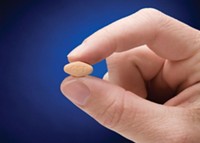Advertisement
Grab your lab coat. Let's get started
Welcome!
Welcome!
Create an account below to get 6 C&EN articles per month, receive newsletters and more - all free.
It seems this is your first time logging in online. Please enter the following information to continue.
As an ACS member you automatically get access to this site. All we need is few more details to create your reading experience.
Not you? Sign in with a different account.
Not you? Sign in with a different account.
ERROR 1
ERROR 1
ERROR 2
ERROR 2
ERROR 2
ERROR 2
ERROR 2
Password and Confirm password must match.
If you have an ACS member number, please enter it here so we can link this account to your membership. (optional)
ERROR 2
ACS values your privacy. By submitting your information, you are gaining access to C&EN and subscribing to our weekly newsletter. We use the information you provide to make your reading experience better, and we will never sell your data to third party members.
Pharmaceuticals
Congress aims to lower US drug prices
Hearings in Senate, House kick off effort to make pharmaceuticals affordable
by Britt E. Erickson
January 31, 2019
| A version of this story appeared in
Volume 97, Issue 5

US lawmakers are shining a spotlight on the high costs of insulin and other prescription drugs that millions of Americans need to survive. Both chambers held hearings Jan. 29, marking the beginning of a series of investigations planned this year to examine the effects of skyrocketing pharmaceutical prices on families.
Witnesses at both hearings spoke about horrifying experiences that their children with type 1 diabetes faced when they became young adults and lacked enough money to pay for insulin.
When he was a freshman in college, Hunter Sego decided to ration his insulin because he could not afford full doses, his mother, Kathy Sego, told the Senate Finance Committee. One vial of insulin costs her son $487, Sego, a choir teacher from Indiana, testified. The same insulin costs $10 in Hungary, she noted.
Hunter needed four vials per month, but he could afford only one, she said. He became sick. Fortunately, his family intervened and he recovered, she said.
Antroinette Worsham, a mother of two daughters with type 1 diabetes, was not as lucky. Her older daughter, Antavia, died at 22 from diabetic ketoacidosis, the result of not having enough insulin. The high cost of the drug was beyond her financial means, Worsham testified to the Oversight and Reform Committee in the House of Representatives.
Worsham fears the same thing will happen to her younger daughter when she turns 21 and is no longer eligible for the state health-care program that now pays for her insulin.
The cost of insulin today is 13 times as high as it was in 1996, Sen. Ron Wyden (D-OR), ranking member of the finance committee, noted at the hearing. But it’s not just insulin prices that are rising: the high costs of many other drugs, including those for treating hepatitis C and cancer, are also straining families, he said.
The Senate Finance Committee recently investigated how Gilead Sciences priced its hepatitis C drug, Sovaldi. “Setting that price was not about recovering R&D costs,” Wyden said. “The company charged a list price of $1,000 per pill because they knew they could get away with it.”
Wyden and the chair of the committee, Sen. Chuck Grassley (R-IA), invited representatives from the largest pharmaceutical companies to testify to explain the increases. They all declined.
The senators pledged to hold additional hearings this year on the topic and to use their power, if needed, to compel CEOs of drug companies to testify.
“They will come before this committee,” Wyden said.



Join the conversation
Contact the reporter
Submit a Letter to the Editor for publication
Engage with us on Twitter